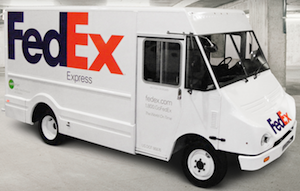
When you join one hundred others in your community to order online, the 100 of you saved 100 trips to nearby stores and to distant malls. You saved hours of driving and gallons of gasoline from distant oil fields. You reduced emissions that smog our air and trap heat for 100 years fueling more draughts and wildfires.
As we increasingly work, shop and take action online, we free productive hours and help our nations energy security. Our nation’s use of oil peaked 6 years ago before we went into a recession. We are getting smarter and more efficient.
Your orders may trigger products that are delivered by FedEx, UPS, and postal trucks traveling a well-organized route. Your orders also now include services that were once physical goods as you read a magazine online, download music, and watch streaming video. Small iPads are replacing big stereos and digital content is replacing bulky goods, allowing more packages to fit in each delivery vehicle.
4.5 Million Delivery Trucks Start to Go Electric
Delivery trucks are increasingly hybrids that sip diesel and gasoline instead of gulping. Thousands of trucks are now all-electric. The potential is huge. As the Electric Vehicle Coalition points out, 4.5 million vehicles in the U.S. are short-haul delivery vehicles. Although it would be impractical to get a big long-haul truck across the nation on electricity, it can be practical to charge 100 short-haul delivery trucks at the warehouse where they load. Half of these delivery trucks are Class 1 and 2, no bigger than a Ford F-150. Delivery vehicles create a major opportunity for the U.S. to shift from oil dependency to using our electricity that is increasingly produced from natural gas and renewables.
FedEx just added 34 all-electric vehicles to its SF Bay Area delivery fleet, bringing its global total to 130 all-electric vehicles. The 100-mile range of the electric trucks, made by Navistar and Smith Electric, exceeds the 88-mile average of FedEx trucks in urban routes.
Since 2005, FedEx has improved fleet efficiency in planes and trucks by over 16 percent. FedEx has also experimented with extending electric range using fuel-cell vehicles. For now, it is going with all-electric and hybrids, and not using plug-in hybrid or fuel cell. Some of FedEx’s 364 hybrid-electric vehicles use innovative Eaton hydraulic hybrid drive systems to achieve 40 percent fuel savings.
In New York City, the Postal Service has had 30 electric 2-ton vehicles on the street since 2001. They were recently joined in Long Island, NY, by two 2-ton hybrid electric vehicles. The USPS uses medium-duty hybrid electric vans from Eaton Corporation and Azure Dynamics. They join the 10 existing Hybrid-Electric Ford Escape vehicles currently in the fleet. USPS Fleet
Not all delivery vans are big 2-tons designed for hundreds of packages. The smaller Ford Transit Connect Electric is the best size for many locations. AT&T, Southern California Edison, Xcel Energy, DTE, Johnson Controls, New York Power Authority, and Canada Post use this delivery van. As Ford continues to expand its electric vehicle offerings, the new Ford C-MAX Energi will also be used by companies big and small.
Large Electric Trucks for Port and Local Demands
Some of the goods that we order start their U.S. journey when cargo ships dock in our ports. Current diesel-powered port trucks in California emit significant amounts of toxic pollutants and greenhouse gas emissions and consume thousands of gallons of fuel. New battery-powered heavy-duty trucks reduce diesel fuel consumption and pollution. The Port of Los Angeles has been using 20 Balqon electric container terminal tractors, hostlers, and 5 electric drayage trucks. The 60-mile electric range of the truck fits with the constrained demands of port work.
For example, for the Port of Los Angeles, TransPower took 2 heavy-duty trucks, formerly with diesel engines, and retrofitted with electric motors and other electronics powered by lithium ion batteries for greater efficiency and reduced emissions. The vehicles are both Class 8 truck tractors designed to haul loads up to 80,000 pounds. They are the Navistar International Pro-Star on-road tractor and a Kalmar Ottawa off-road tractor; both converted to operate as battery-powered, zero-emission vehicles.
Not every delivery requires ships, trucks, and long distances. Sometimes I pedal my bicycle to a farmers market where local growers bring in fresh produce. I taste, buy, and load my backpack for the ride home. Unfortunately, these San Francisco hills keep getting steeper and I’m thinking of buying an electric bike.
A growing number of under 100-mile daily urban delivery demands are excellent fits for e-bikes to electric vans to massive electric trucks. The electrification of 4.5 million short-haul vehicles has the potential to lower annual fuel costs by billions and create a shift from oil dependency to using U.S. natural gas and renewable energy.

0 thoughts on “Hundreds of Electric Delivery Trucks Today, Millions Tomorrow”